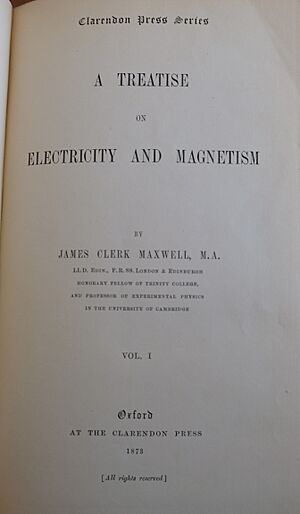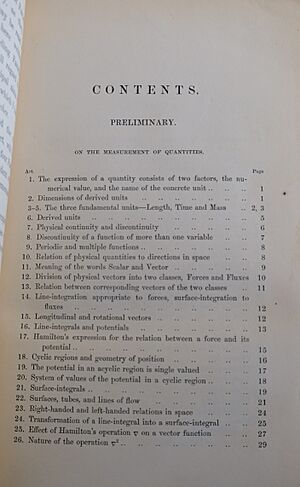A Treatise on Electricity and Magnetism facts for kids

Title page from volume I of Maxwell's masterwork
|
|
| Author | James Clerk Maxwell |
|---|---|
| Country | England |
| Language | English |
| Subject | |
| Genre |
|
| Publisher | Oxford University Press |
|
Publication date
|
1873 |
| Text | A Treatise on Electricity and Magnetism at Wikisource |
A Treatise on Electricity and Magnetism is a very important science book. It was written by James Clerk Maxwell in 1873. This book is all about electromagnetism. Electromagnetism is the study of how electricity and magnetism are connected.
Maxwell's book was published in two parts. He was working on a new version when he passed away in 1879. Other scientists, like William Davidson Niven and J. J. Thomson, helped finish and update the book later.
Contents
About This Important Book
This book is known for being quite hard to read. It has many big ideas. But it doesn't always explain them in the simplest way. One science historian said that Maxwell's book had so much information. It sometimes hid his most important discoveries. These discoveries included how electromagnetic waves are made. These are the waves that carry radio signals and light.
Maxwell's Big Ideas
Maxwell introduced the idea of vector fields in his book. A vector field is a way to show how forces or other things spread out in space. Think of wind arrows on a weather map. Each arrow shows wind direction and speed. Maxwell used special letters for these fields:
- A is for vector potential.
- B is for magnetic induction.
- C is for electric current.
- D is for displacement.
- E is for electric field.
- F is for mechanical force.
- H is for magnetic field.
Maxwell's book showed how different parts of physics are linked. He connected ideas from other scientists. This helped people see the natural world as one big, connected system. This was a big change from older ideas.
What's Inside the Book
The book starts by explaining how to measure different things in science. Then it is split into four main parts.
Part I: Electrostatics
This part talks about electricity when it is not moving. It covers:
- How electric charges behave.
- The basic math behind electricity.
- How energy is stored in electrical systems.
- Simple examples of how things get charged.
- How to use special tools to measure electricity.
Part II: Electrokinematics
This section is about electricity that is moving. This is what we call electric current. It explains:
- What an electric current is.
- How electricity flows through different materials (conduction).
- How much a material resists electricity (resistance).
- What happens when electricity passes through liquids (electrolysis).
- How to measure electric resistance.
Part III: Magnetism
This part focuses on magnetism. It covers:
- The basic ideas of magnetism.
- How magnetic forces work.
- Different types of magnets.
- How materials become magnetic (induced magnetization).
- How to measure magnetic forces.
- The Earth's own magnetism.
Part IV: Electromagnetism
This final part brings electricity and magnetism together. This is where Maxwell's most famous ideas are found. It discusses:
- The force between electric currents.
- How electric currents can create other currents (induction).
- The general rules that govern electromagnetism.
- How electric and magnetic units are measured.
- The connection between energy and stress in electromagnetism.
- Maxwell's amazing idea that light is an electromagnetic wave.
- How magnetism can affect light.
See also
- "On Physical Lines of Force"
- "A Dynamical Theory of the Electromagnetic Field"
- Introduction to Electrodynamics
- Classical Electrodynamics


